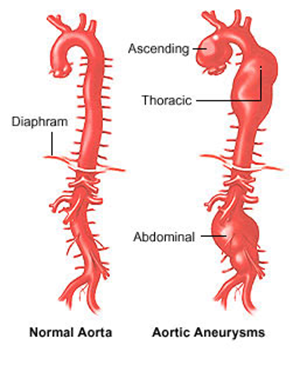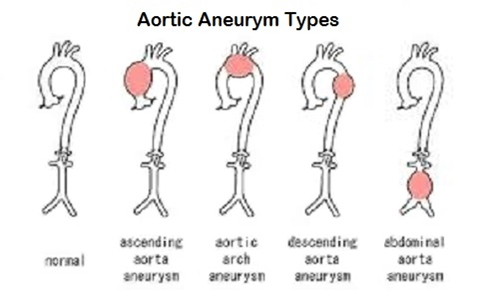Types of Aortic Aneurysm


 Image Removed
Image Removed
Renal Artery Aneurysm
 Image Added
Image Added
There are many ways to ask if someone has an aneurysm. If the person has prior history of a particular type of aneurysm, say, aortic aneurysm, and the physician suspects that the patient suffers from another one, then specialized imaging instruments that are location-specific can be used. Examples are TRANSESOPHAGEAL ECHOCARDIOGRAPHY or TRANSTHORACIC ECHOCARDIOGRAPHY, they are used to look for abnormalities in the chest and in the abdomen. The original data elements provided to us by DUKE and ACC, from which we created the examples in the CV-imaging TAUG, whether a patient has an aneurysm is asked in a pre-specified fashion? Does the patient have:
Aortic aneurysm? Aortic arch aneurysm?
Abdominal aneurysm? etc.
However, often times when patients complain about discomforts and pain, it is hard to pinpoint the exact location of an aneurysm hence MRI and CT scan are the most frequently used tools to detect aneurysm. In this case, the test location is often broadly defined as chest, abdominal cavity, or the whole-body. The specific location(s) where aneurysms are found are actually locations for the results, not testThis example shows a discrete aneurysm in the aorta. In this instance, the MRI imagining identified the presence of an aneurysm in the chest of a subject, which is in the aorta (RESLOC), extending from the aortic arch to the abdominal aorta (RLOCTX).
| Dataset wrap |
|---|
|
| Rowcaps |
|---|
Rows 1-2: | Show the presence of subject ABC-123 has a single aortic aneurysm from a chest MRI scan. |
|---|
Rows 3-4: | Show the Shows the said aneurysm is 7.5cm in length (diameter), which is measured from the aortic arch to the abdominal aorta and 3.7cm in width. |
|---|
| Rows 4-5: | Show subject ABC-456 is found to have aneurysms in two locations from a whole-body MRI Scan: RENAL ARTERY and THORACIC AORTA. |
|---|
|
| Dataset2 |
|---|
Row | STUDYID | DOMAIN | USUBJID | CVSEQ | CVGRPID | CVTEST | CVORRES | CVORRESU | CVLOC | CVMETHOD | VISITNUM | VISIT | CVDTC | | CVRESLOC 1 | CVRESLOC 12 | CVRLOCTX |
|---|
| 1 | ABC | CV | ABC-123 | 1 | 1 | Aneurysm Indicator | Y | | CHEST | MRI | 1 | BASELINE | 2020-04-27 | | |
| |
|---|
| 2 | ABC | CV | ABC-123 | 2 | 1 | Number of Aneurysms | 1 | | CHEST | MRI | 1 | BASELINE | 2020-04-27 | | |
| |
|---|
| 3 | ABC | CV | ABC-123 | 3 | 1 | Aneurysm Length/Diameter | 7.5 | CM | CHEST | MRI | 1 | BASELINE | 2020-04-27 | | AORTA |
| Aortic Arch to Abdominal Aorta |
|---|
| 4 | ABC | CV | ABC-456 | 1 | 2 | Aneurysm Indicator | Y |
| ABDOMINAL CAVITYBODY | MRI | 1 | BASELINE | 2020-04-27 |
|
|
|
|
|---|
| 5 | ABC | CV | ABC-456 | 2 | 2 | Number of Aneurysms | 2 |
| ABDOMINAL CAVITYBODY | MRI | 1 | BASELINE | 2020-04-27 |
| RENAL ARTERY | ABDOMINAL THORACIC AORTA |
|
|---|
|
|

This example shows the minor axis cross-sectional diameter measurements of the left and right ventricle of the heart, at end ventricular diastole.
| Dataset wrap |
|---|
|
| Rowcaps |
|---|
Row 1: | Shows the cross-sectional diameter of the left ventricle at end ventricular diastole, measured along the minor axis and specifically at the location of the high papillary muscle. The further anatomical details at which the measurement is set and performed is represented by the CVLOCTX NSV. |
|---|
Row 2: | Shows the cross-sectional diameter of the right ventricle at end ventricular diastole, measured along the minor axis and specifically at just below the tricuspid valve. The further anatomical details at which the measurement is set and performed is represented by the CVLOCTX NSV. |
|---|
|
| Dataset2 |
|---|
Row | STUDYID | DOMAIN | USUBJID | CVSEQ | CVTESTCD | CVTEST | CVORRES | CVORRESU | CVLOC | CVMETHOD | VISITNUM | VISIT | CVDTC | | CVLOCTX |
|---|
| 1 | ABC | CV | ABC-123 | 1 | MNDIAEVD | Minor Axis Cross-sec Diameter, EVD | 3.7 | CM | HEART, LEFT VENTRICLE | TTE | 1 | BASELINE | | | High papillary muscle level |
|---|
| 2 | ABC | CV | ABC-123 | 2 | MNDIAEVD | Minor Axis Cross-sec Diameter, EVD | 3.2 | Cm | HEART, RIGHT VENTRICLE | TTE | 1 | BASELINE | | | Below the tricuspid valve |
|---|
|
|




